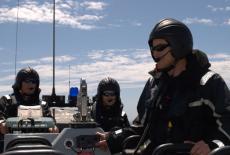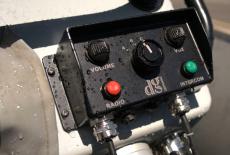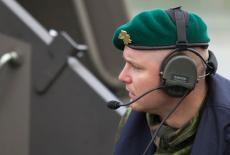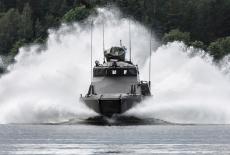Next Generation Marine Communication Systems

07.12.2015
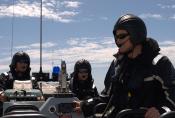
Workboat Communications Evolve to Meet Myriad Missions
Over the past decade we have come to expect fast, seamless global communications from a single device that fits in our pocket.
The age of the smart phone and tablet enables multiple voices talking in a conference call and real time transfer of data, ranging from documents to photos and videos. Most crew members now have a GPS in their pocket which can identify where the person is on the planet.
The automotive and leisure marine industry has been quick to adopt GPS as a standard feature on all sizes of cars and boats. For the travelling mariner, communication devices such as the iPhone or iPad can be loaded with ‘navigation’ apps. However, there are distinct differences between having vast amounts of data and knowing where you are in real time, to actually navigating and passage planning.
A challenge when the marine sector moved from paper charts to digital charting was too much complexity plus a lack of uniform menus, commands and controls across different navigation systems. Commercial objectives drive innovation in design, but the danger of ‘feature creep’ can be adding functions to an electronic device for no reason.
On a dark and stormy night, or at high speeds, a navigation system that delivers the minimum amount of relevant and clearly presented information should be the usability objective. How the navigator or captain transmits information externally and onboard to various crew members from engine room to deck crew can also be critical.
Communications Technology for Military and Security Applications
Slow moving workboats are well served by communications that have evolved from industrial land based systems. However, as small boat operations increase both operating speeds and demands on the crews the next generation of maritime communications may be using technology that has been developed for military and security applications.
As the expectations for communications performance grows it is worth considering how military and security roles are driving changes and improvements in the systems. ‘Milspec’ quality is becoming an industry norm for portable electronics in harsh marine environments. Next generation systems may have a ‘net’ function with other types of communication, including the ability to transmit data to or upload images from mobile units.
Various systems designed for military and security applications could improve safety and efficiency for the offshore sector, renewable energy, wind farms, fish farming, aquaculture, survey and scientific work. The main difference between military and civilian for some communication systems may simply be the use of encryption...
The traditional system for external marine communication is VHF radio. Combined transmitters and receivers operate on standard international frequencies or channels. Aerials mounted high can give a ‘ship to ship’ VHF range of over 50 nautical miles. Range between small boats with low aerials can be less than 5 nautical miles in certain conditions. This limited range of VHF is a benefit in crowded waters as it reduces the overlap of radio traffic between small vessels. A vessel in distress wants other vessels in range to come to their assistance, as they will often be first on the scene in areas where there is limited rescue coverage.
Mariners on small craft are still trained in VHF techniques with focus on the mayday distress call. Digital Selective Calling (DSC) capability allows a distress signal to be sent with a single press button on the radio which can be integrated with onboard GPS to transmit position. There is now a strong link between GPS and communication as the digitally generated location is expected to be more accurate than human error interpreting a position or confusion from spoken words and numbers in a voice only distress call.
Marine Communications Evolve and Adapt
However in day to day communications voice is still used. A simplex system only allows communication in one direction at a time. A duplex system is where each person can speak simultaneously and hear each other at the same time. A two-way system is like talking on the telephone. Headsets combine speakers and microphones which can also be incorporated into helmets. On professional vessels headsets should have industrial grade hardware that resists corrosion and be engineered for comfort. For the marine environment a headset usually wraps around the back of the wearers head so that when leaning over to handle a line or look down a ladder climb, the headset does not fall into the water or onto the deck. Grabbing for a falling headset can be fatal if the operator needs both hands for their task. Hands free microphones can also offer safety benefits.
Wind, wave and engine noise combine to make communicating among crew members difficult. High volume and poor quality communications can result in misunderstood radio messages, accelerated crew fatigue and slow reaction times. Many marine operations need to listen clearly to military, police, fire and emergency VHF transmissions, but due to external noise radio calls can be missed or have to be repeated. If communication among crew members requires shouting it can create a situation where work and safety messages are subject to interpretation errors. By turning the radio volume up crews can be subjected to short term ringing in the ears and long term hearing damage. The latest low noise or noise cancelling systems are designed to give high quality communication combined with hearing protection.
Operating in Harsh Marine Environments
UK based company Drumgrange have developed the Diamond intercom & radio combiner system as a digital system for use on RHIBs, high-speed craft and small vessels. The compact system is designed as a combined communications solution for military, coast guard and commercial open boat applications. The Diamond system provides voice connectivity between users and on-board radios. It also integrates existing boat alarms, for example engine warning alarm, to support boat and crew safety.
Suzanne Coop, Business Development Manager for Drumgrange said, ‘The Diamond system was developed to stringent end-user requirements for operations in harsh maritime environments. The system balances intuitive functionality and ease of use with a robust, low-maintenance design. In high tempo operations the system enables crew members to have independent access to both secure and non-secure communication networks, uninterrupted hands free intercom facilities and full control of voice-activated comms.’
The intercom & radio combiner system can accommodate any radio and user combination with up to eight radios and eight users as a basic system. Key features include user-specific VOX sensitivity control and users have the ability to personalise voice-activated comms at any time. The ergonomic design is for single hand operation during high-speed transits at sea. The system is ruggedized for land and maritime use, waterproof to minimum IP67 and will work with most headset configurations, including binaural headsets which enable users to have a different communications input through each ear.
Onboard Intercoms from Military to Superyacht
Intercom systems can use hard wired or wireless equipment for onboard communication between crew members. There may be a master control on the system or individuals can select what they want to hear. Some systems allow operators to listen to external radio and comms transmissions while listening to onboard crew conversations. Safety benefits of onboard intercoms include situational awareness on the vessel and commands that do not have to be repeated in demanding marine environments. Whether it is a Superyacht or a commercial vessel, docking manoeuvres put high pressure on crew communication as the risk of injuring a crew member or damaging the ship is high. This is no time for a radio battery to go flat or a microphone to fail.
UK company Ultra Electronics provides the Graytronics Marine Communications & Intercom System. The system is designed to provide clear audio under extreme conditions for civil forces and in military applications. Intercoms used in an open marine environment suffer from background noise from engines and wind turbulence around the microphone. To overcome this noise, Ultra Electronics has designed speech processors which modify the audio signal and allow only specified frequencies to pass through, greatly reducing noise and increasing speech clarity.
Bede O’Neill, Business Development Manager at Ultra Electronics said, ‘Graytronics communication and intercom systems enable multiple radios, secure and non-secure, to be integrated with crew intercoms and marine safety helmets. A typical system comprises master control box with connections for radio operators, crew intercoms and one to six radios. The wireless option enables the crew to maintain communications whilst remote from the wired intercom, a necessity when performing Search and Rescue operations. Fully backwards compatible with existing installations, Graytronics Wireless delivers a key system enhancement with minimal disruption to installed systems.’
Other system options include integration with waterproof loud hailer, waterproof loudspeaker, waterproof radio fist microphone and waterproof mobile telephone module. Ultra CCS Graytronics Communications systems are fitted on the US Coast Guard’s new Long Range Interceptor-II Cutter Boats. Professional sector clients include navy, search and rescue, police and commercial operators.
C3 - Command Control Communication
Patrol vessels are used increasingly around the world to protect large areas of water and coastline. The ships boat is then launched to board a suspect craft. Visit, Board, Search, Seizure (VBSS) are maritime boarding actions that range from counter-narcotics and anti-piracy to conducting immigration, customs, safety, fisheries and other compliance inspections. Boarding team communications is part of C3 (Command Control Communication) that enables VBSS and military teams to board other vessels with the option to talk ‘radio to radio’ or to a wider network, including the boarding team boat crew and mother vessel.
The SAVOX Communications Group is a Finnish company with headquarters in Luxembourg and operations in Finland, Germany, France, the UK, the US, Canada and China. The SAVOX IMP Mobile Platform is designed to deliver clear, reliable and robust communications for military, SAR, law enforcement and professional missions. SAVOX IMP offers a lightweight Ethernet based digital solution where the man is the communication interface. Configurable and scalable the system can be configured for small crews or large vessels. The programmable software enables integration of intercom, radio and high speed data transfer.
The SAVOX user interface or Personal Control Unit (PCU) is a lightweight and ergonomic voice prompted unit providing control of intercom functions and instant access to two tactical radios. The PCU can be operated with one hand whilst wearing gloves, even when moving at speed in rough sea states. The IMP has an adaptive VOX algorithm allowing high quality voice operated communication on open boats whilst travelling at high speeds.
Mikael Westerlund, SVP Global Marketing at SAVOX Communications said, ‘SAVOX IMP is a maritime command and control system that integrates intercom, radio control and a common core platform for high speed data distribution around the craft. The system has been designed to provide high quality communications across a wide range of sea states in open boat operations. The system is proven in extreme conditions and temperatures ranging from the cold of the Arctic to hot desert environments. Features include Bluetooth and Smartphone interface. The configuration options are designed to be flexible and modular. At the core of IMP is a digital 100Mb Ethernet backbone. This data highway provides high capacity voice and data distribution using Ethernet protocols. It allows integration with navigation aids, engine management systems and video data which can be distributed to key user positions for complete command and control of the vessel. SAVOX IMP is user configurable and has no system master, meaning quick and easy set up.’
Expanding Operational Capability
Drumgrange Maritime Interdiction Operating System (MIOS) is designed to expand operational capability for patrol and boarding operations. MIOS incorporates automated navigation, position tracking, video and data links between a command vessel and deployable remote assets, including interdiction craft and boarding parties. The MIOS C3 system has been developed by Drumgrange using MOTS (Military Off The Shelf) software and hardware. Specialist features include hands-free voice comms, integrated comms helmet, portable computer, digital scanner and camera, secure digital imaging, hazardous gas detectors, position and track data.
Suzanne Coop of Drumgrange added, ‘This marine C3 system provides the command team, interdiction craft and boarding party with simultaneous, instant updates of asset location and the developing tactical situation. This enables personnel and assets to be deployed with greater safety, confidence and effectiveness. MIOS provides secure voice communications together with long range video and data linking the command vessel with the interdiction craft and deployed personnel. The central command position is linked via an integrated communications network to a mobile automated navigation display with asset tracking capability.’
As the marine industry has an increasing need for information beyond voice communication it is likely that these state of the art systems will integrate with commercial maritime processes from basic port security to safety inspections and condition based maintenance. For example, transmitting images of worn engineering components on a wind farm tower may enable inspection and analysis ashore with decisions made in real time. Flexible communications packages may have higher up front costs but as long as the capability and requirement is clearly understood the payback could improve working practices and safety with reduced operation and maintenance costs.
By John Haynes
The author is an Associate Fellow of the Nautical Institute, Yachtmaster Ocean and Advanced Powerboat Instructor. Subject matter expertise includes high speed craft consultancy, product development and specialist training.
Images
- RHIB crew with DIAMOND intercom and radio communications system. Credit Drumgrange
- DIAMOND Intercom and Radio Combiner System. Credit Drumgrange
- A member of the amphibious arm of the Finnish Navy, a Finnish Coastal Jaeger, equipped with IMP headset and PCU. Credit Savox Communications
- Marine Alutech Watercat M18 AMC is the Finnish Navy's new U700-class amphibious assault craft with Savox command and control system, intercom capabilities and radio interconnection. Credit Rolls Royce
Workboat Communications Evolve to Meet Missions by John Haynes
All images are copyright RIB & HSC 2024 unless otherwise stated.
This does not exclude the owner's assertion of copyright over the material.

23.09.2024
MCA MGN550 - Lithium-ion Batteries Guidance
Marine Guidance Note 550: 'Electrical Installations - Guidance for…
05.01.2024
The Challenges of Unpredictable Marine Energy
From military to superyacht, it is clear there is an urgent…
International WorkBoat Show 2024
Dates:
12 to 14 November 2024
Location:
Morial Convention Center, New
Foiling and Flying RIBs
Foiling powerboat designed to meet military needs - fast, stable, silent, fuel-saving. Collaboration by SEAir Foiling Systems and Sillinger RIBs.…














